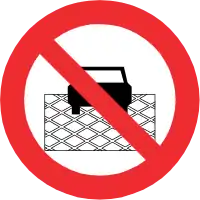Box junction
A box junction is a road traffic control measure designed to prevent congestion and gridlock at junctions. The surface of the junction is typically marked with a yellow criss-cross grid of diagonal painted lines (or only two lines crossing each other in the box), and vehicles may not enter the area so marked unless their exit from the junction is clear, or they are intending to turn and are prevented from doing so by oncoming traffic, or other vehicles on the box waiting to turn.

Box junctions were introduced in the UK during 1967, following a successful trial in London.[1] In both Ireland and the United Kingdom (where cars drive on the left), drivers may enter the box and wait when they want to turn right and are stopped from doing so only by oncoming traffic or by other vehicles waiting to turn right.[2]
Box junctions may be painted on other areas of roadway which must be kept free of queuing traffic, such as exits from emergency vehicle depots, level crossings and car parks.
Box junctions are most widely used in many European countries such as Cyprus, Ireland, Malta, Portugal, Serbia and the United Kingdom; in parts of the United States, such as New York and Colorado;[3] and other countries, including Canada , Hong Kong,[4] Singapore, Malaysia,[5] the Philippines,[6] South Africa , Taiwan[7] and Brazil.
Unmarked equivalents

In Australia, New Zealand and the European Union (excluding Ireland), road rules state that every intersection is a box: that is, the driver may not enter any intersection unless there is clear space on the other side, whether it is marked or not. In the EU this also applies to junctions with a minor road within the waiting area of a traffic light on the major road. This is generally respected, though rarely in Germany, but the diagonal grid is still painted on some congested intersections to remind drivers of the rule and on level crossings where blocking the intersection could cause an accident. The same rule applies at every intersection in Russia.[8]
Several U.S. states have enacted laws intending to decrease gridlock at intersections, railroad crossings, and marked crosswalks which prohibit motorists from entering any of the three until they are certain their vehicle can clear it, as recommended by Uniform Vehicle Code section 11–1112.[9] Examples include California,[10] Florida,[11] and Ohio.[12] No special road markings are used to indicate this rule, but some governments post warning signs to increase awareness of the law at problematic intersections.
References
- Motor Cycle, 23 March 1967, p.378 More Box Junctions . Accessed and added 2014-06-10
- "The Highway Code - Road junctions (170-183)". Retrieved 2009-08-27.
- "Chapter 3B - Pavement and Curb Markings". Manual of Uniform Traffic Control Devices. Federal Highway Administration. Retrieved July 30, 2016.
- "Traffic Light Junctions". Hong Kong: Transport Department. Retrieved 6 May 2017.
- "Public reminded to keep out of yellow box". New Strait Times. September 22, 2014.
- "13.6: 'Do Not Block Intersection' lines", Highway Safety Design Standards, Part 2: Road Signs and Pavement Markings Manual, Philippines: Department of Public Works and Highways, p.127
- "第一百七十三條 網狀線,用以告示車輛駕駛人禁止在設置本標線之範圍內臨時停 車,防止交通阻塞。其劃設規定如左" [Section 173: Crosshatched lines, used to inform the driver that no vehicles can enter in the location where there is need to stop to prevent traffic jams]. 道路交通標誌標線號誌設置規則. Taiwan: Ministry of Transportation and Communications. October 13, 2012. p. 190. Retrieved July 30, 2016 – via Wikimedia Commons.
- Section 13.2 of traffic code
- National Committee on Uniform Traffic Laws and Ordinances (1979). Traffic Laws Annotated. Washington, D.C.: National Highway Traffic Safety Administration. p. 312. Retrieved 11 February 2018.
- California Vehicle Code Section 22526.
- Fla. Stat. Section 316.2061.
- Ohio Revised Code Section 4511.712.
External links
| Wikimedia Commons has media related to Box junctions. |